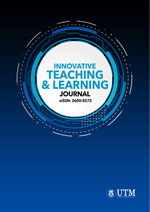A review of trends and applications of learning analytics in higher education in the post-pandemic era
DOI:
https://doi.org/10.11113/itlj.v7.131Keywords:
learning analytics, higher education, online learningAbstract
Learning analytics is defined as collecting, analysis, and reporting of data about learners inside a system. Users’ interaction, which is a form of digital traces can be processed and identified into pattern. In comparison with subjective methods such as surveys and questionnaires, learning analytics provide deeper insight on students’ behaviour and assist learning institution with data-informed decision-making regarding students’ learning issues. This paper reviews on existing literature on the latest application and the trends of learning analytics in higher education over the last few years, within the period of pre and post pandemic era. As online learning was adapted rapidly during the pandemic, learning analytics became an important tool to assess students’ learning. The literature review was obtained from Scopus and Web of Science databases by using Boolean search techniques with the right keywords. This study reviewed and provided a comprehensive analysis according to certain criteria of searched studies from the year 2018 to 2023. The result showed that the research trend in learning analytics was fluctuating in Scopus and gradually declining in Web of Science due to the pandemic and shifts in research interest. In this post pandemic era, Artificial Intelligence (AI) is trending upwards, and researchers are putting interest in integrating AI with learning analytics in education. As such, this paper could help educators see the trends of LA over the last few years, as well as the innovative practices recently.

















